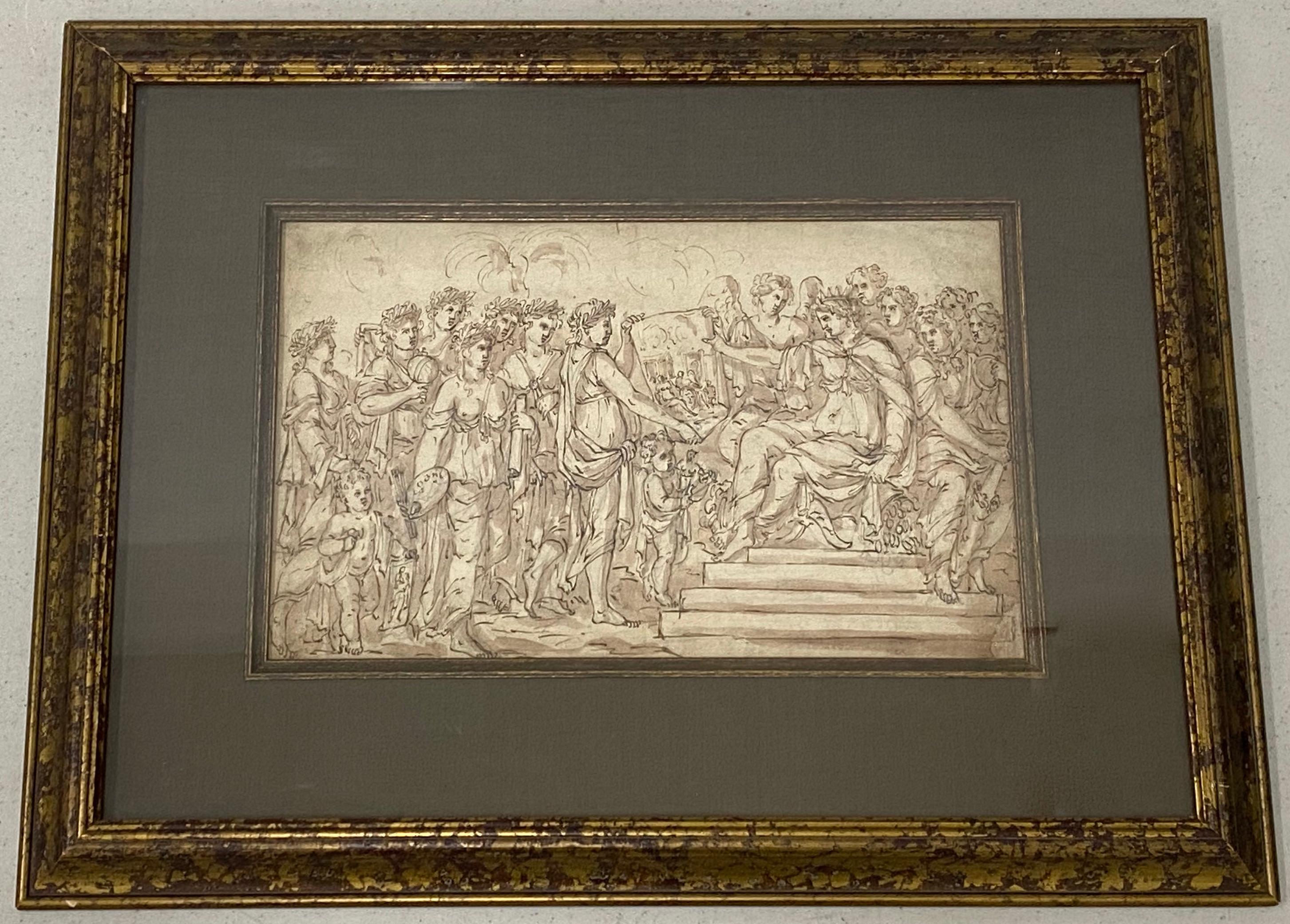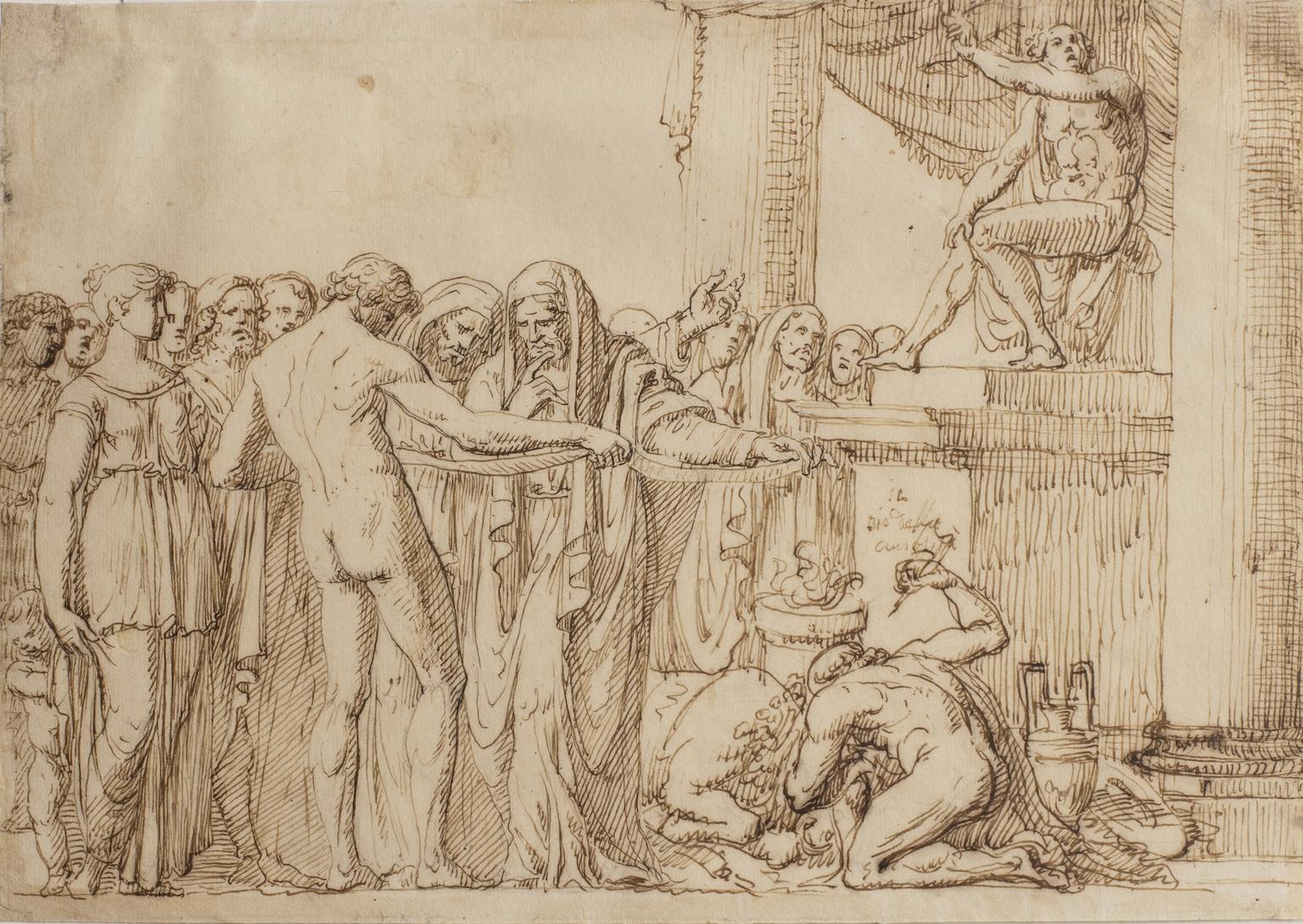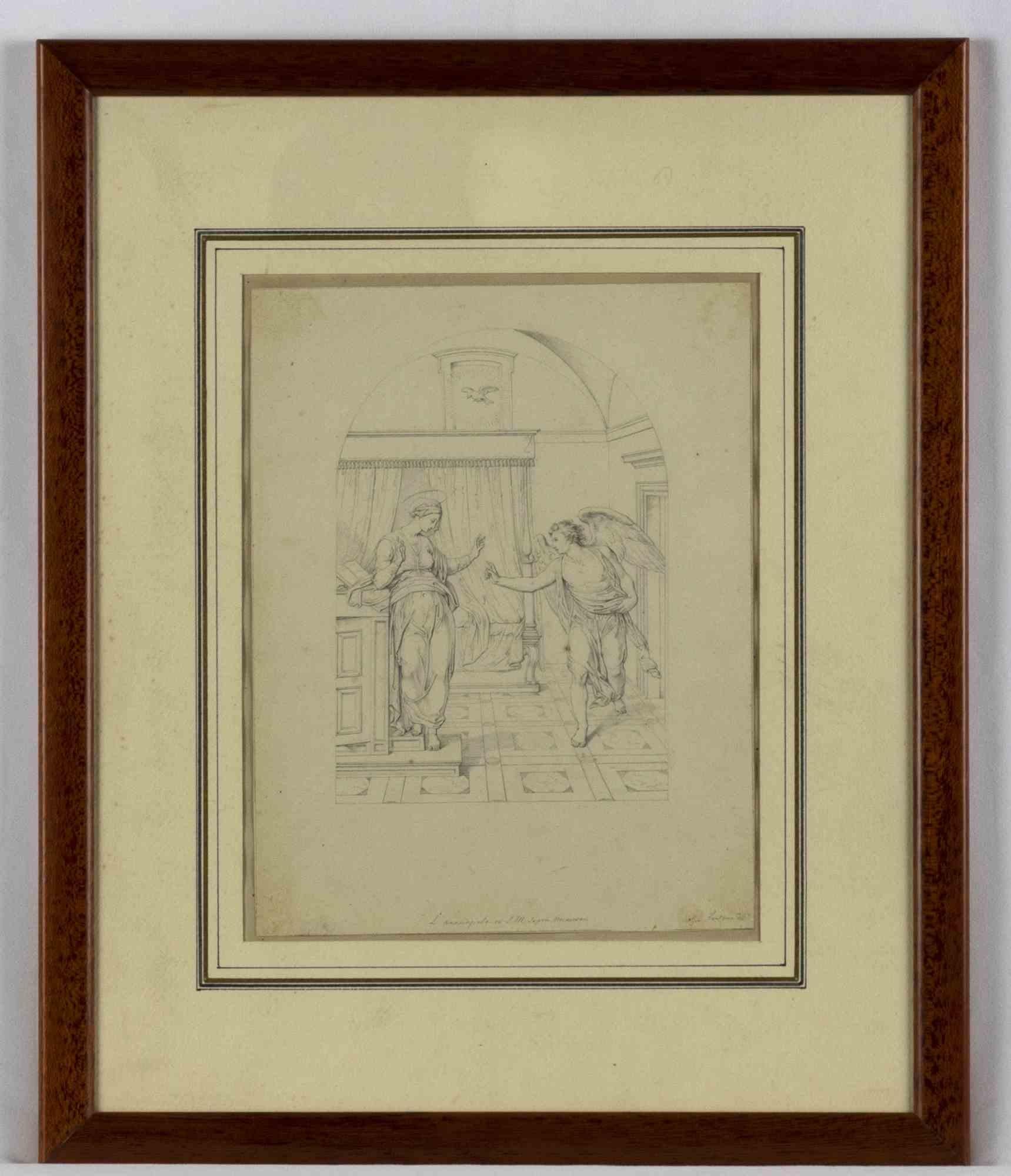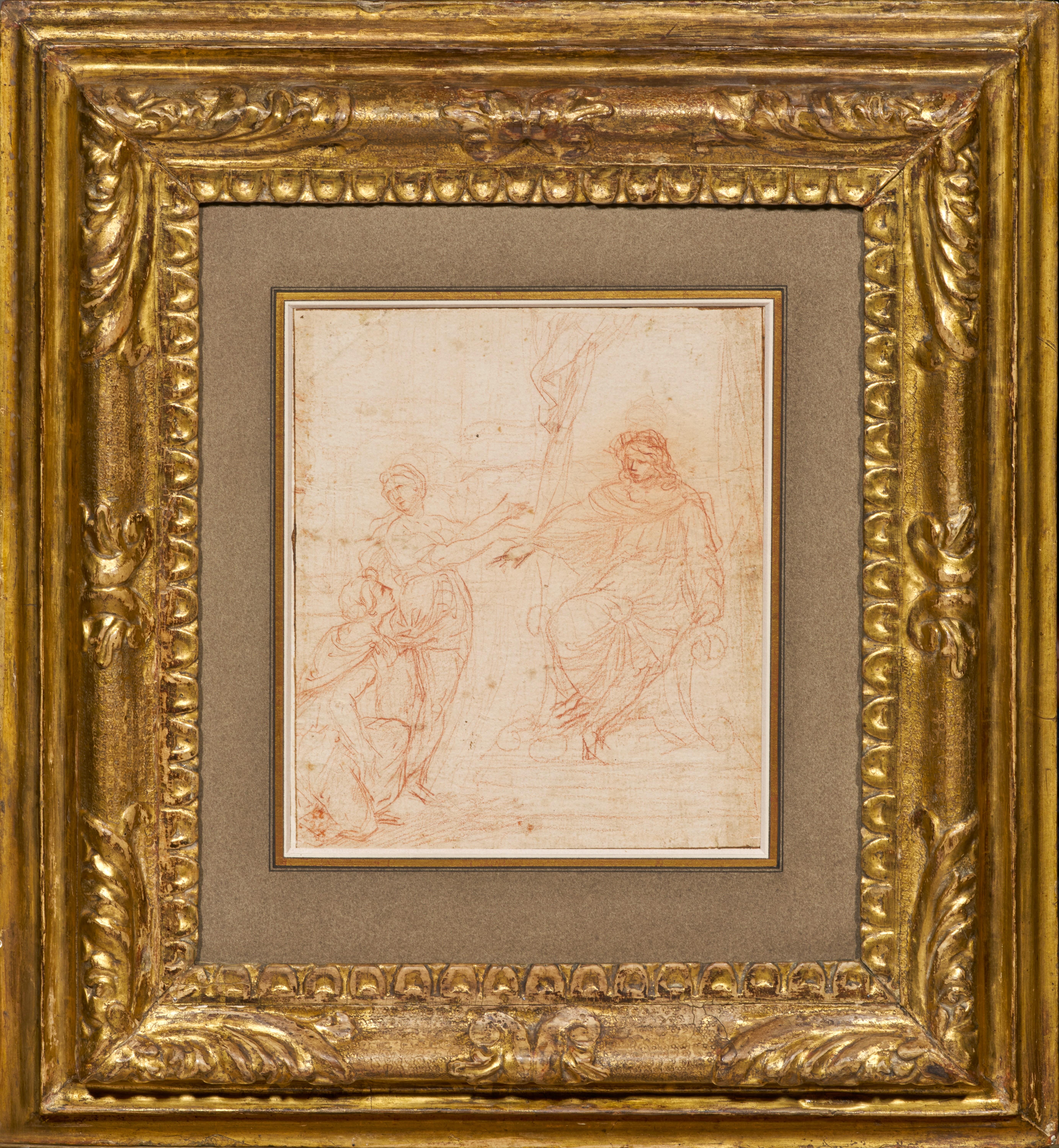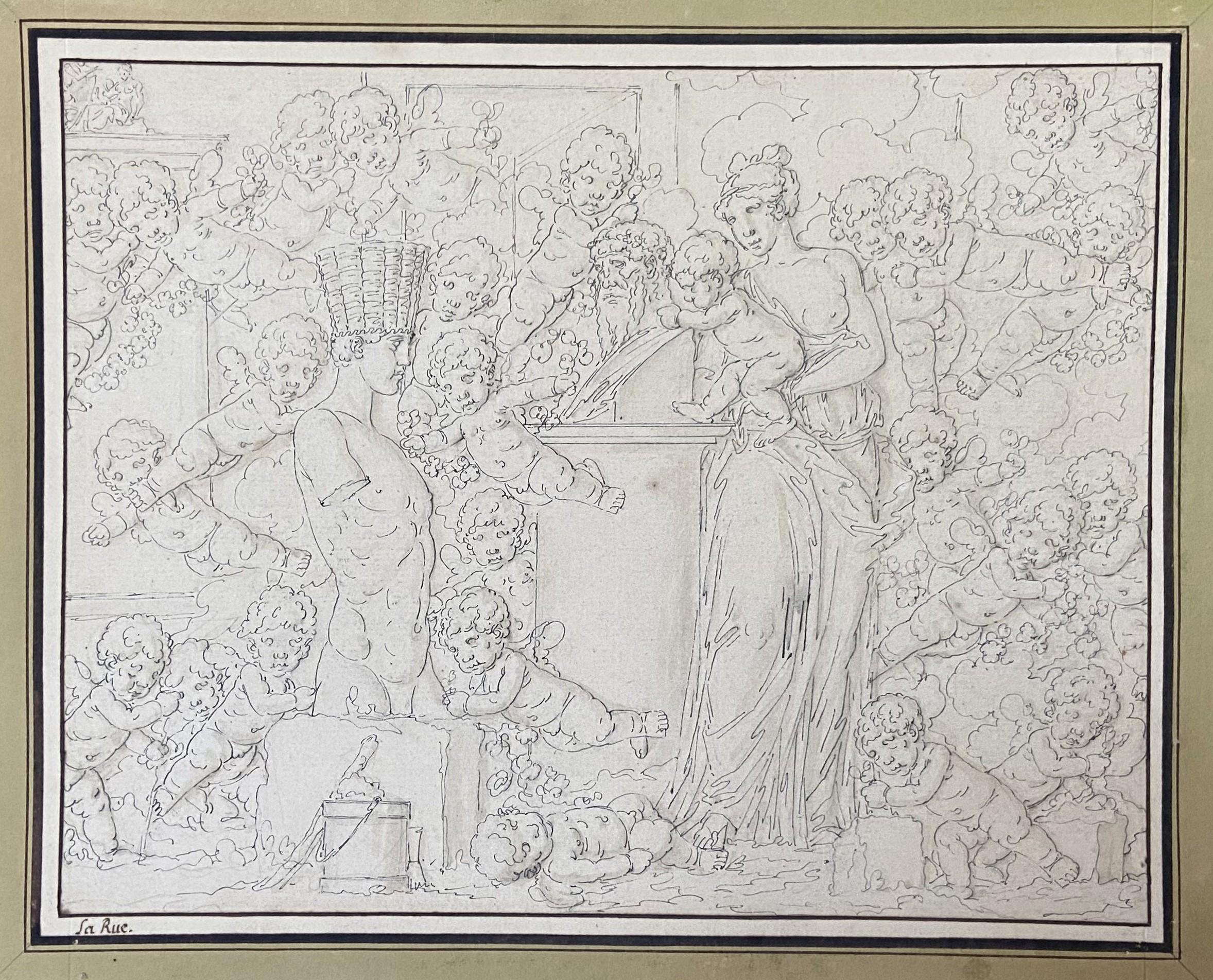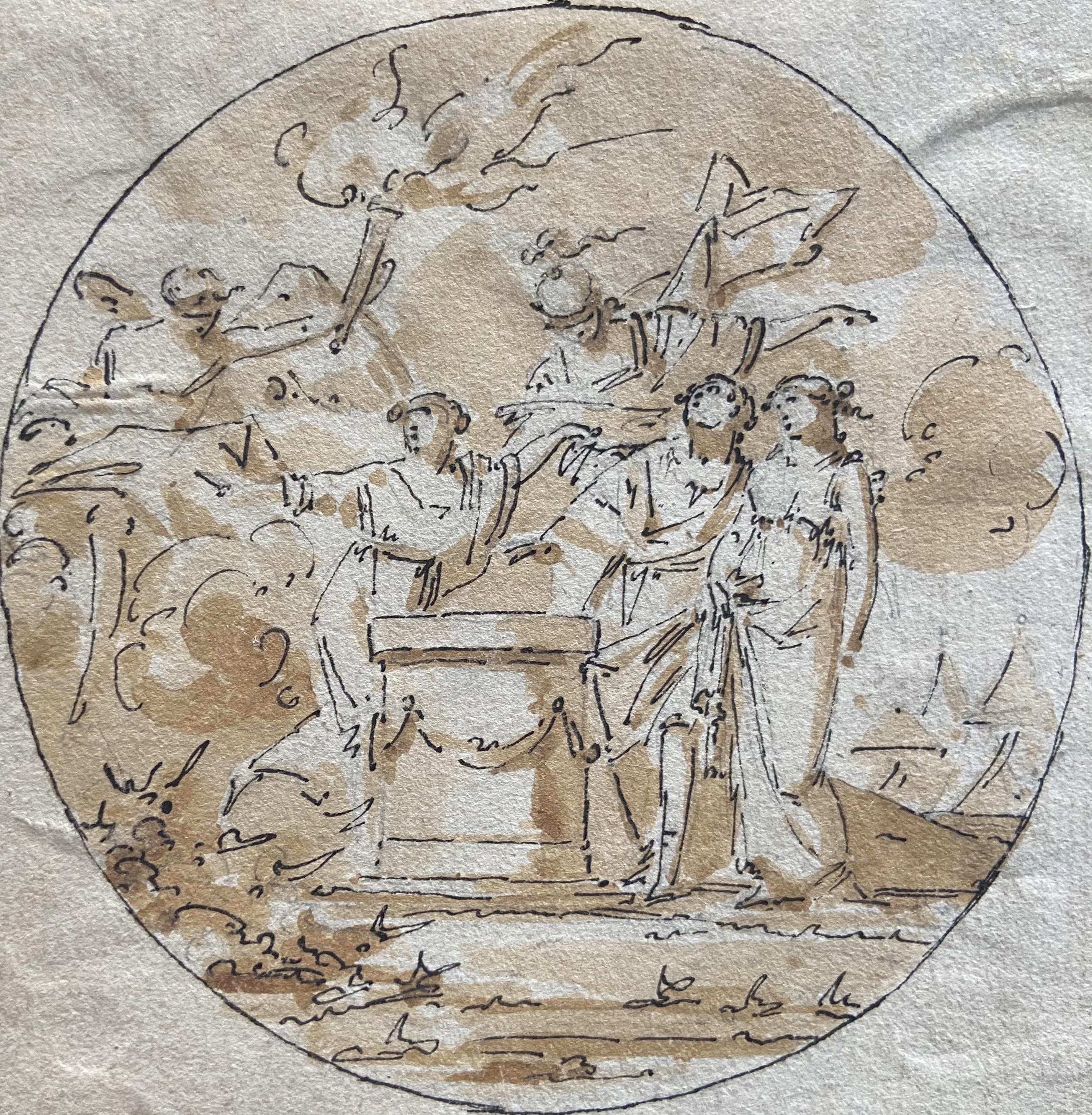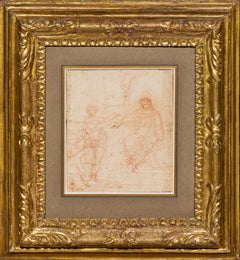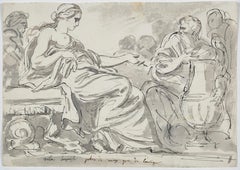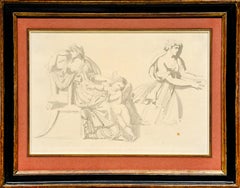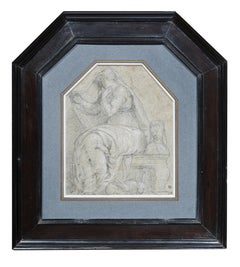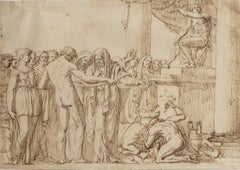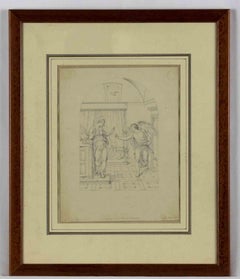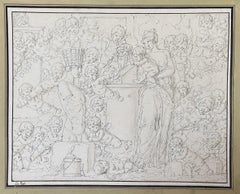Items Similar to Allegory of the Treaty of Angoulême, a drawing attributed to Donato Mascagni
Want more images or videos?
Request additional images or videos from the seller
1 of 7
Allegory of the Treaty of Angoulême, a drawing attributed to Donato Mascagnica. 1625
ca. 1625
$13,003.86
£9,703.04
€11,000
CA$18,093.23
A$20,246.74
CHF 10,532.58
MX$243,957.79
NOK 132,600.32
SEK 125,285.22
DKK 83,751.35
About the Item
We would like to thank Mrs. Ursula Verena Fischer Pace for suggesting the attribution to Donato Arsenio Mascagni.
We were immediately seduced by the rich tonalities of this allegory executed in brown ink wash. A comparison with a drawing in the Louvre also previously attributed to Mola suggests an attribution to Donato Mascagni, an early 17th-century Florentine artist with an international career.
The composition of the scene leads us to make an iconographic proposal, suggesting that it is a celebration of the Treaty of Angoulême, which on April 30, 1619 sealed the reconciliation between the young King Louis XIII and his tumultuous mother, Queen Marie de Médicis, depicted here paying homage to Minerva, under the aegis (literally and figuratively) of a cardinal.
1. Attribution Proposal
Our drawing, executed in pen and ink wash over red chalk, features characteristical nervous lines, exploiting the spaces left in reserve and the chromatic variations of the wash to chisel out the various figures. Its style seems perfectly consistent with an attribution to the Florentine or Sienese school of the early 17th century.
This distinctive workmanship can be compared with a drawing in the Louvre, also formerly attributed to Mola, which has recently been reattributed to Mascagni and depicts a holy monk healing a child (4th picture in the Gallery).
The Musée du Louvre holds another drawing by Mascagni, which is probably more insolate, making comparison with our sheet less immediate. Mascagni's corpus is still very small, since these two drawings are practically the only ones attributed to him to date... but the comparison with the sheet formerly attributed to Mola seems particularly enlightening.
2. Donato Mascagni, a painter and traveller in Medici Florence
Born in Florence in 1579, Donato Mascagni entered the studio of the great Counter-Reformation painter Jacopo Ligozzi (1547-1627). Ligozzi had been appointed capomaestro of the Florentine grand-ducal art studio, superintendent of the Medici gallery and first court painter in 1574, following Vasari's death. Mascagni's talent was quickly recognized and, in 1593, the young artist was admitted to the prestigious Accademia del Disegno, after which he began to work more independently.
Over the following years, Mascagni completed several important projects for the monks of the Camaldolese order, including a prestigious commission for the lunettes in the cloister of Santa Maria dei Angeli in Florence (1598). In 1605, Mascagni pronounced his vows in the Servite order, taking the name "Fra Arsenio"; he then lived in the monastery of Monte Senario, some twenty kilometers north of Florence, until 1609, when he obtained a papal dispensation to move to the Santissima Annunziata in the city center.
Mascagni's artistic career continued to flourish in Tuscany, and he eventually won commissions abroad, which took him as far as Spain (Valladolid in 1615) and Austria (Insbruck in 1612, Salzburg from 1616 to 1619 and in 1624). He may also have traveled to Rome, where some suggest he worked with Guido Reni. In 1632, Mascagni moved back to Florence, to the Santissima Annunziata, where he remained until his death in 1637.
3. Iconographic proposal
The scene depicted in our drawing is both rich and complex: a sovereign, characterized by her crown and ermine coat, pays homage to Minerva, the goddess of Reason and War, who holds in her hands her shield on which is painted the portrait of a cardinal. A young man with a broad moustache attends the scene and stands behind the sovereign.
By placing this scene in a Florentine context of glorification of the members of the Medici family, one hypothesis seems interesting: to recognize in the sovereign the Queen of France Marie de Médicis and in the young man her son the young King Louis XIII, and to link this allegory to the signing of the Treaty of Angoulême, which sealed the reconciliation between Marie de Médicis (1575 - 1642) and her son on April 30, 1619.
This episode was depicted by Rubens in one of the paintings in the gallery commissioned by the Queen and executed around 1622-1625 (5th picture in the gallery). In March 1619, the Queen had escaped from the Château de Blois, where she had been exiled by her son the King after he ordered the assassination of Concino Concini, and she had taken refuge in Angoulême. Louis XIII preferred negotiation to confrontation, and called on Richelieu, a protégé of the Queen Mother, to negotiate a reconciliation. This was made official with the signing of the Treaty of Angoulême on April 30, 1619, by which the King ceded the towns of Angers, Chinon and Les Ponts-de-Cé to his mother, but forbade her to return to the Council.
In Rubens' painting, the Queen is seated on a throne adorned with the statue of Minerva, with Vigilance at her side. She welcomes Mercury, who has descended from Olympus to hand her an olive branch as a sign of peace. Two cardinals advise her: on Mercury's right, Cardinal François de La Rochefoucauld, with a positive attitude; on the left, Cardinal Louis de Nogaret de La Valette or Cardinal de Guise (but not Richelieu, who did not become a cardinal until 1622 and was not present at the signing of the Treaty), with a rather reserved, wait-and-see attitude.
Our scene, probably executed several years after the event, brings together a number of elements that bring it closer to Rubens' allegory: the Queen is shown kneeling before the statue of Minerva (which adorned the right side of the throne in Rubens' painting) and the shield held in Minerva's hand (the aegis) is adorned with the portrait of a cardinal. This could be either Cardinal de La Rochefoucauld or Richelieu (now a cardinal). Two other busts of cardinals appear on a pedestal to the left of our drawing, and could represent Cardinal de la Valette and Cardinal de Guise.
The group of five figures on the right is also very interesting. The main figure with the long moustache could represent the young Louis XIII, if we accept that this long moustache was inspired more by a later portrait of the King than by those contemporary with the Treaty (last picture : portrait of Louis XIII by Philippe de Champaigne in 1635).
The woman in the center of the female group on the left could be Queen Anne of Austria, who married Louis XIII in 1615. Interestingly, the portraits of the courtiers surrounding the two sovereigns are executed with great vivacity, particularly that of the elderly bearded man behind the sovereign (perhaps Charles d'Albert (1578-1621), appointed Duc de Luynes in 1619, who had advised him to call on Richelieu).
4. Framing
To frame this drawing, we have chosen a Louis XIII period frame with floral motifs, whose delicate carving harmonizes with the decorative richness of this allegory.
- Attributed to:Donato Arsenio Mascagni (1579 - 1637, Italian)
- Creation Year:ca. 1625
- Dimensions:Height: 9.5 in (24.13 cm)Width: 11.75 in (29.85 cm)
- Medium:
- Movement & Style:
- Period:1620-1629
- Condition:Pen and brown ink, brown wash over red chalk sketch Dimensions : 6 3/8 ‘’ x 8 ½’’ (162 x 217 mm) - Framed: 9 ½’’ x 11 ¾’’ (24 x 30 cm) Louis XIII period carved and gilded wood frame with floral motifs.
- Gallery Location:PARIS, FR
- Reference Number:1stDibs: LU1568216361172
About the Seller
5.0
Vetted Professional Seller
Every seller passes strict standards for authenticity and reliability
Established in 2020
1stDibs seller since 2021
10 sales on 1stDibs
Typical response time: 3 hours
- ShippingRetrieving quote...Shipping from: PARIS, France
- Return Policy
Authenticity Guarantee
In the unlikely event there’s an issue with an item’s authenticity, contact us within 1 year for a full refund. DetailsMoney-Back Guarantee
If your item is not as described, is damaged in transit, or does not arrive, contact us within 7 days for a full refund. Details24-Hour Cancellation
You have a 24-hour grace period in which to reconsider your purchase, with no questions asked.Vetted Professional Sellers
Our world-class sellers must adhere to strict standards for service and quality, maintaining the integrity of our listings.Price-Match Guarantee
If you find that a seller listed the same item for a lower price elsewhere, we’ll match it.Trusted Global Delivery
Our best-in-class carrier network provides specialized shipping options worldwide, including custom delivery.More From This Seller
View AllStudies for the Judgment of Solomon, a double-sided drawing by Simone Cantarini
Located in PARIS, FR
In this double-sided red chalk study, Simone Cantarini offers us a double reflection on the theme of the Judgment of Solomon. This sheet reveals his precise style and his sense of de...
Category
1640s Old Masters Figurative Drawings and Watercolors
Materials
Chalk, Laid Paper
Study in the Antique Style, a neoclassical drawing by Augustin Pajou
Located in PARIS, FR
In this lively and fresh drawing, probably taken from one of the artist's notebooks, Pajou presents us with a composition freely inspired by antiquity, as a souvenir of a visit to th...
Category
1750s Old Masters Figurative Drawings and Watercolors
Materials
Ink
Frieze of antique figures, a drawing by the sculptor Antoine-Denis Chaudet
Located in PARIS, FR
Faithful to the neo-classical taste, sculptor Antoine-Denis Chaudet presents us with a frieze of antique figures executed in gray wash over pencil strokes, which is likely inspired b...
Category
Early 1800s Old Masters Figurative Drawings and Watercolors
Materials
Paper, Pencil, Ink
Allegory of Chastity, a drawing attributed to G. Porta with great provenance
Located in PARIS, FR
This magnificent drawing from the Venetian Renaissance intrigues us in many ways. It depicts an allegorical composition whose meaning partly escapes us: a veiled figure seated on a stone bench (which we have identified as Chastity), seems to be turning away from a woman's bust beside her, below which are two rabbits, a traditional allegory of fertility, but also sometimes of lust.
This drawing, executed on blue paper, undoubtedly belongs to the Venetian Renaissance. The inscriptions on the back of the old mounting board indicate the various attributions considered by its last owner, the British painter and art historian Sir Lawrence Gowing. We have retained the attribution to Giuseppe Porta proposed by art historian John Arthur Gere as the most relevant.
We were incredibly fortunate to find a hexagonal frame of a very similar format for this drawing, the upper corners of which were formerly cut (irregularly). This 17th-century Dutch frame comes from an aristocratic collection in Lombardy, and creates a kind of fascinating chase around this Venetian drawing...
Category
16th Century Figurative Drawings and Watercolors
Materials
Chalk
Study for a Frontispiece, a baroque drawing by Giovanni Antonio Pellegrini
By Giovanni Antonio Pellegrini
Located in PARIS, FR
This masterly frontispiece study, executed with a very sure hand, testifies to the survival of the great Baroque taste in 18th century Venice. It could be one of the very last works by Giovanni Antonio Pellegrini: the few lines that cross the papal arms evoke those of Benedict XIV, who became pope in 1740, one year before the artist's death.
1. Giovanni Antonio Pellegrini and the European influence of Venetian history painting in the 18th century
Giovanni Antonio Pellegrini was born in Venice in 1675 and trained in the studio of the Milanese painter Paolo Pagani (1655 - 1716). Pagani, who had been living in Venice since 1667, took him to Moravia and Vienna from 1690 to 1696. After a stay in Rome from 1699 to 1701, Pellegrini married Angiola Carriera in 1704, the sister of the great pastelist Rosalba Carriera.
From 1708 onwards, Pellegrini left Venice and began an extensive tour of Europe: he worked in England between 1708 and 1713, where he met great success, particularly at Kimbolton Castle and Castle Howard. He then worked in Germany and the Netherlands, then in Bohemia and Austria, before returning briefly to England in 1719. In 1720 he was in Paris where he decorated the ceilings of the Royal Bank for John Law...
Category
1740s Old Masters Figurative Drawings and Watercolors
Materials
Ink
The Martyrdom of Saint Bartholomew, a preparatory drawing by Alessandro Casolani
Located in PARIS, FR
This powerful pen and brown ink wash drawing is a study for an altarpiece depicting The Martyrdom of Saint Bartholomew. Signed and dated 1604, it was painted at the end of his life b...
Category
Early 1600s Old Masters Figurative Drawings and Watercolors
Materials
Ink, Pen
You May Also Like
18th to 19th Century "Art Presentation" Old Master Drawing
Located in San Francisco, CA
18th to 19th Century "Art Presentation" Old Master Drawing
Remarkable old master pen, ink and wash drawing of an art presentation
Dimensions 14" wide x 8.5" high
The lightly distr...
Category
Early 19th Century Figurative Drawings and Watercolors
Materials
Ink, Watercolor
Figurative drawing neoclassical Tuscan historical subject from the 19th century
By Francesco Nenci
Located in Florence, IT
The proposed attribution for this drawing in brown ink on paper is the name of the painter and academician of the Tuscan-Roman neoclassical cohort Francesco Nenci (Anghiari, April 19...
Category
Early 19th Century Other Art Style Nude Drawings and Watercolors
Materials
Paper, Ink
L'Annunziata in S. M. - Drawing by Giovanni Fontana - 16th Century
By Giovanni Fontana
Located in Roma, IT
L'Annunziata in S. M. sopra Minerva is an original old master artwork realized by Giovanni Fontana.
Ivory colored sheet attached on an ivory colored cardboard ( cm 35.8 x 26.7)
Bea...
Category
16th Century Old Masters Figurative Drawings and Watercolors
Materials
Paper, Pencil
$4,344 Sale Price
25% Off
Louis-Félix de La Rue (1730-1777) A Mythological scene, drawing
By Louis-Félix Delarue
Located in Paris, FR
Louis-Félix de La Rue (1730-1777)
A Mythological scene
Pen and black ink on paper
Bears an old inscription with the name of the artist on the lower left bo...
Category
1770s Old Masters Figurative Drawings and Watercolors
Materials
Ink
French school 18th Century, A mytholological scene with a couple, drawing
Located in Paris, FR
French school 18th Century,
A mytholological scene with a couple,
Pen and brown ink, brown ink wash on paper
11.5 x 11.5 cm, diameter of the main scene : 10,5 cm
in a modern frame under glass : 33.5 x 33.5 cm
This drawing by a particularly talented 18th-century artist - as yet unidentified - is notable for its mastery of pen and wash...
Category
1760s Old Masters Figurative Drawings and Watercolors
Materials
Ink
18th Century Watercolour - Court Scene
Located in Corsham, GB
Signed and dated indistinctly under the mount. Presented in a gilt frame and wash-line mount. On paper.
Category
Early 18th Century Figurative Drawings and Watercolors
Materials
Watercolor
$290 Sale Price
20% Off
More Ways To Browse
Masters Drawings Signed
Old Master Drawings Framed
Allegory Paintings
The Great Escape
Spain Old Masters
Mother Child Drawing
Albert Young
Antique Minerva
Red Cardinal
Dating Antique Picture Frames
King Throne
Old Medici
Marie Albert
Old Master Mother Child
Floral Old Masters
Albert Link
Antique Goddess Painting
Kneeling Woman
